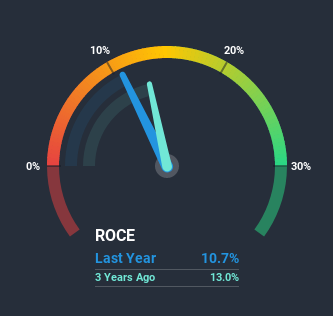The Trends At Metro Performance Glass (NZSE:MPG) That You Should Know About

What trends should we look for it we want to identify stocks that can multiply in value over the long term? Firstly, we'll want to see a proven return on capital employed (ROCE) that is increasing, and secondly, an expanding base of capital employed. Basically this means that a company has profitable initiatives that it can continue to reinvest in, which is a trait of a compounding machine. However, after briefly looking over the numbers, we don't think Metro Performance Glass (NZSE:MPG) has the makings of a multi-bagger going forward, but let's have a look at why that may be.
Understanding Return On Capital Employed (ROCE)
Just to clarify if you're unsure, ROCE is a metric for evaluating how much pre-tax income (in percentage terms) a company earns on the capital invested in its business. Analysts use this formula to calculate it for Metro Performance Glass:
Return on Capital Employed = Earnings Before Interest and Tax (EBIT) ÷ (Total Assets - Current Liabilities)
0.11 = NZ$23m ÷ (NZ$258m - NZ$41m) (Based on the trailing twelve months to March 2020).
Thus, Metro Performance Glass has an ROCE of 11%. That's a relatively normal return on capital, and it's around the 9.8% generated by the Building industry.
View our latest analysis for Metro Performance Glass
In the above chart we have measured Metro Performance Glass' prior ROCE against its prior performance, but the future is arguably more important. If you'd like, you can check out the forecasts from the analysts covering Metro Performance Glass here for free.
How Are Returns Trending?
Over the past five years, Metro Performance Glass' ROCE and capital employed have both remained mostly flat. Businesses with these traits tend to be mature and steady operations because they're past the growth phase. With that in mind, unless investment picks up again in the future, we wouldn't expect Metro Performance Glass to be a multi-bagger going forward. That being the case, it makes sense that Metro Performance Glass has been paying out 63% of its earnings to its shareholders. If the company is in fact lacking growth opportunities, that's one of the viable alternatives for the money.
What We Can Learn From Metro Performance Glass' ROCE
In summary, Metro Performance Glass isn't compounding its earnings but is generating stable returns on the same amount of capital employed. And investors may be expecting the fundamentals to get a lot worse because the stock has crashed 80% over the last five years. On the whole, we aren't too inspired by the underlying trends and we think there may be better chances of finding a multi-bagger elsewhere.
If you want to know some of the risks facing Metro Performance Glass we've found 2 warning signs (1 is significant!) that you should be aware of before investing here.
For those who like to invest in solid companies, check out this free list of companies with solid balance sheets and high returns on equity.
This article by Simply Wall St is general in nature. It does not constitute a recommendation to buy or sell any stock, and does not take account of your objectives, or your financial situation. We aim to bring you long-term focused analysis driven by fundamental data. Note that our analysis may not factor in the latest price-sensitive company announcements or qualitative material. Simply Wall St has no position in any stocks mentioned.
Have feedback on this article? Concerned about the content? Get in touch with us directly. Alternatively, email editorial-team@simplywallst.com.



